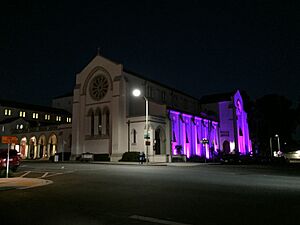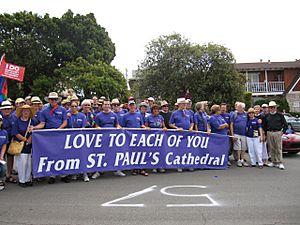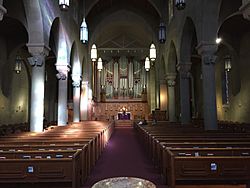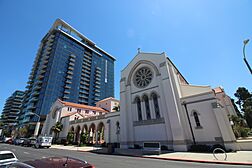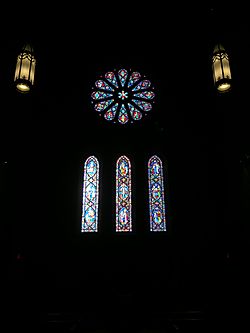St. Paul's Cathedral (San Diego) facts for kids
Quick facts for kids St. Paul's Cathedral, San Diego |
|
|---|---|
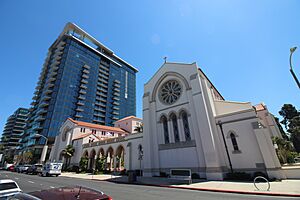
St. Paul's Episcopal Cathedral in 2022
|
|
| 32°44′1″N 117°9′35″W / 32.73361°N 117.15972°W | |
| Location | 2728 Sixth Avenue San Diego, California |
| Country | United States |
| Denomination | Episcopal |
| Website | stpaulscathedral.org |
| History | |
| Status | Church |
| Founded | 1869 as Holy Trinity, reincorporated at St. Paul's in 1887 |
| Architecture | |
| Functional status | Active |
| Architect(s) | Philip Frohman |
| Style | Neo-Gothic |
| Groundbreaking | 1950 |
| Completed | First worship in 1951; technically still unfinished. Named as cathedral in 1985 |
| Administration | |
| Diocese | Episcopal Diocese of San Diego |
| Province | Province VIII |
St. Paul's Cathedral is an Episcopal church located in the Bankers Hill area of San Diego, California. It serves as the main church for the bishop of the Episcopal Diocese of San Diego. The church's history goes back to the very first Protestant church in San Diego, which started in Old Town in 1853. However, the building you see today was finished much later, in 1951.
Contents
What St. Paul's Cathedral Believes
St. Paul's Cathedral is a lively and growing church community. They call themselves "the Cathedral 4 the City." Their goal is to combine old traditions of worship and sacred music with new ideas. They want to help solve important social problems in the world.
Everyone is welcome at St. Paul's, no matter their background or beliefs. On Sundays, the church tells everyone that "whoever you are and wherever you are on the journey of faith, you are welcome." This means they invite everyone to join in their activities. They also practice "open Communion." This means anyone who loves Jesus or wants to love him more can take part in the special meal.
The church follows traditional Christian worship styles. But they also work closely with other religions in the community. For example, they work with the local Islamic community to help people understand and respect different faiths.
How People Worship at St. Paul's
St. Paul's uses a special prayer book called the Book of Common Prayer. Every Sunday, there's an early service at 8:00 am. After that, at 10:30 am, there's a larger service with a choir, a procession, and chanted prayers. There's also a traditional Choral Evensong at 5:00 pm.
During the week, morning and evening prayers are held online. Every Friday at 12:00 pm, there's a special service called Eucharist in a smaller chapel inside the cathedral. This chapel is called the Chapel of the Holy Family.
Besides regular services, St. Paul's has unique events. These include a labyrinth walk on New Year's Eve and a "Zydeco Mass" on Mardi Gras. They also have neighborhood parades on Palm Sunday and St. George's Day. Another special event is the Blessing of the Animals.
Learning and Community Activities
The cathedral offers many learning opportunities for adults every Sunday. A "forum" at 9 am discusses interesting topics. These can range from religious practices to environmental issues. They also talk about ways to volunteer and help in the community. Throughout the year, there are often classes during the week.
For children, there are special Sunday gatherings. Child care is also available during the 10:30 am service. Many small groups and ministries meet regularly. St. Paul's also uses the internet and social media to connect with people.
In the 1950s, the church's leader, Harold Robinson, helped start a place for older adults to live. This is now called St. Paul's Senior Homes and Services. The Dean of St. Paul's Cathedral is the president of its board. This organization helps homeless seniors, among other services.
Music at the Cathedral
St. Paul's is well-known for its music program. It is led by the Canon for Music, Martin Green. There are three choirs at the church. The adult choir sings at the 10:30 am Sunday service. The Cathedral Choristers (boys and men) and St. Cecilia's Choir (girls and men) take turns singing at the weekly Evensong.
Many concerts are held at the cathedral. These include chamber music and choral works, and they are open to everyone. The cathedral is also home to the Pacific Academy of Ecclesiastical Music (PACEM). It has a very large music library.
The cathedral's Aeolian-Skinner organ is a historic instrument. Parts of it come from the first organ in San Diego, built in 1887. This organ was moved to the church's current location in the 1950s. It was made bigger several times with more parts and keyboards. In 2011, the church raised money to fix the organ. It was taken apart and sent away for a full repair. A temporary digital organ was used while it was gone. The restored organ was back in place by December 2012.
The organ is used for weekly concerts on Tuesdays at noon. It is also played during worship services. Carol Williams, who has been the Civic Organist of San Diego since 2001, is also the Organist in Residence at St. Paul's.
Helping the Community and Social Justice
St. Paul's cares a lot about helping people and promoting fairness in San Diego and beyond. The cathedral works with the Uptown Community to help those in need. Every year, St. Paul's hosts a group of adults who do not have homes for several weeks. They also give out food weekly in the church parking lot with Jewish Family Services.
The church community also works to help people who are new to the country. It has a Spanish-speaking group and reaches out to Hispanic communities. A big charity effort is supporting Vida Joven. This is a home for children in Tijuana, Mexico, whose parents are in jail. The cathedral also cares about environmental issues. They try to be as "green" as possible. During the Advent season, they have an Alternative Gift Fair. This fair promotes gifts that are good for the environment and support fair trade.
The St. Paul's Cathedral community openly welcomes all people. The cathedral actively works for equality. They host meetings and movie showings to support this cause. In 2005, St. Paul's held a funeral service for a man named John McCusker. He was not allowed a funeral by another church. St. Paul's is one of the biggest groups marching in the yearly San Diego Pride Parade. In 2010, they received an award for their service from the San Diego Pride organization.
The cathedral spoke out against California's Proposition 8 in 2008. This law took away the right for some couples to marry. After Proposition 8 passed, St. Paul's held a special service. This service helped people and their friends grieve together.
In 2010, the bishop of San Diego allowed churches to bless the partnerships of all couples. St. Paul's Cathedral was the first church in the area to do this. Several couples had their partnerships blessed with a special service. In 2012, the Episcopal Church approved a church-wide service for these blessings. After a court decision in June 2013, the bishop allowed all couples to marry in the diocese. The first wedding for a same-sex couple at St. Paul's happened in July 2013. All couples who want to marry or have a blessing at St. Paul's follow the same rules. This includes counseling before marriage.
How the Cathedral is Run
Like other Episcopal cathedrals, St. Paul's is led by a dean. The current dean is The Very Rev. Penelope Bridges. The cathedral is the main church for the bishop of the Episcopal Diocese of San Diego. A group of leaders called the cathedral chapter helps guide the church. This group includes elected members from the church community and the diocese.
Many other clergy members help out, including some who are retired. Some are also special priests called canons of the cathedral. There are also lay canons, who are church members in administrative roles. Many volunteer groups help the cathedral run smoothly. These include altar servers, vergers, the altar guild, ushers, and greeters.
Cathedral Deans
- 1978–1994: The Very Reverend James Earle Carroll DD (returned as interim dean 2002-2003)
- 1996-2001: The Right Reverend John Bryson Chane (later Bishop of Washington, D.C.)
- 2003–2012: The Very Reverend Scott Richardson
- 2014–present: The Very Reverend Penelope Bridges
History and Building
The church's history goes back to the first Protestant church in San Diego. It was started in Old Town in 1853. This church later became Holy Trinity downtown. In 1887, it was renamed St. Paul's. By 1919, St. Paul's was getting too small for its downtown location. The church leaders bought land across from Balboa Park.
They hired Philip Frohman to design the new church. He was a famous architect known for the neo-Gothic style. He also designed the National Cathedral in Washington, D.C.. The church leaders wanted a large building. They thought St. Paul's would become the main church for San Diego one day. The Great Hall was finished in 1929. But building the church was delayed by the Great Depression and disagreements with the architect. So, construction didn't start until 1950. The first service in the new church was held in 1951, even though it wasn't fully finished. Over the years, a chapel and an office wing were added.
In 1973, the Episcopal Diocese of San Diego was finally created. This happened by dividing the larger Los Angeles diocese. In 1985, St. Paul's officially became the cathedral for this new diocese.
Future Plans for the Cathedral
In 2011, the cathedral finished a plan for its property. This plan suggests building two apartment towers with shops on the ground floor next to the cathedral. It also includes renovating the church campus with new offices and parking. The money from these projects will help support the cathedral's work in the community.
See Also


